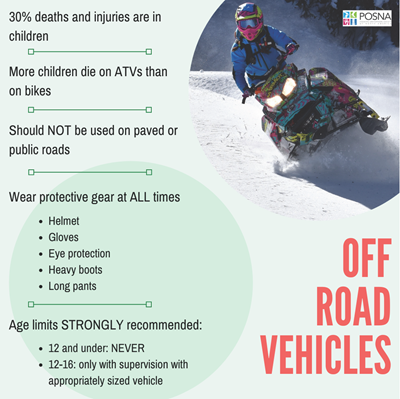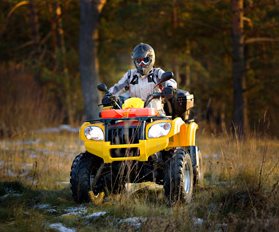Overview
It may seem like an adventure to drive a motorized vehicle, but children are not allowed to drive cars. Automobiles are not allowed to be driven by an inexperienced driver, and it is illegal to travel in a car without a seatbelt. Some children, however, do go out and drive or ride on all-terrain vehicles (ATVs). ATVs are designed for off-road terrain, not paved surfaces. They are difficult to control on paved roads and are at risk of flipping over , hitting cars or being struck by cars. Driving on lawns, dirt roads, and in woods may sound like fun, but it can be very dangerous. ATVs do not have as many safety features as cars, and there are fewer rules for driving ATVs than there are for driving a car..
Common Injuries
Injuries commonly seen from ATVs include eye injuries, minor scrapes and bruises, broken bones, head injuries, spine injuries, and death. ATVs became popular in the 1980s and were often sold as toys. Quickly, people realized that they were dangerous. The Consumer Product Safety Commission (CPSC) reported that there were over 100,000 injuries from ATV’s in 2012 (about 25% involved kids under 16). The CPSC also reported that an average of 568 adults and 144 children died each year between 2001-2008. One out of every five deaths occurred when there was more than one rider on the ATV.

Age Recommendations for ATVs
- ATV drivers of any age should have proper safety training.
- Children under the age of 6 should not be on an ATV as a driver OR as a passenger.
- Children under the age of 12 should not operate an ATV as the driver.
- Drivers between 12 and 16 should not operate an ATV with an engine size of 90 cubic centimeters (90cc) or greater
- ATVs are designed for size and age. Do not let children under 16 operate an adult-sized ATV. Children under 16 lack the coordination, skills and experience to handle an adult-sized ATV.
- Children should always ride an age appropriate ATV with a speed limiter.
What can you do to make riding an ATV safer?
- Wear appropriate safety gear including a helmet, eye protection, gloves, over-ankle boots, long pants and a long-sleeved shirt.
- Get appropriate safety training before riding.
- Do not ride on paved roads.
- Do not carry more riders than the ATV was designed to carry.
- Do not “jump”.
- Ride only in appropriate weather with appropriate lighting.
- Ride only during daylight hours.
- Only ride an ATV designed for your age and size.
- An adult should supervise ATV activities.
References
- Lynch J et al. The continuing problem of All-Terrain Vehicle Injuries in Children. J Pediatr Surg. 1998;33(2)329-332
- Sandler et al. Pediatric “Off-Road Vehicle” Trauma: Determinants of Injury Severity and Type. Pediatr Emergency Care. 2012;28(12):1328-1333.
- Cvilanovich et al. A Population-Based Assessment of Pediatric All-Terrain Vehicle Injuries. Pediatrics. 2001;108(3):631-635.
More Information
Page QR Code:


 POSNA.org
POSNA.org


